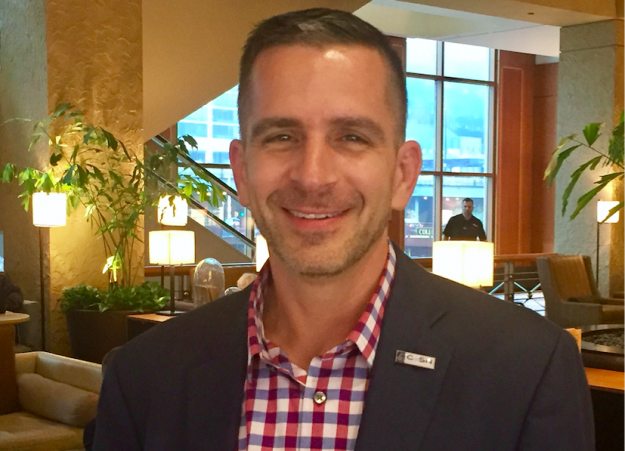Tech chief Scott Smith uses new role to keep innovating in North Carolina district

Less than a decade ago, Scott Smith pioneered a “digital conversion” in his North Carolina school district.
A long-time chief technology officer, Smith helped distribute iPads and other devices to each of the 6,200 students in the Mooresville Graded School District, eventually earning a visit from former President Barack Obama in 2013.
Since then, Smith has taken on an expanded role, transitioning to become Mooresville’s assistant superintendent of elementary instruction and technology. He continues to oversee technology initiatives in the district, but focuses now on quality instruction in K-12 schools — and specifically at ways to leverage technology and digital resources so they support teaching and learning.
Smith recently sat down with EdScoop’s Wyatt Kash to answer questions about upcoming projects, cybersecurity, the cloud and how to transform the digital content of a school district — regardless of size, funds and resources. His answers have been lightly edited for brevity and clarity.
Can you share what new applications, learning management systems or technology tools you are using to keep things moving forward?
We’re highly digital. We use Blackboard as our learning management system — we’ve had a learning management system for years.
We switched to Blackboard a couple of years ago and that piece is just part of who we are and what we do. We have moved … almost completely digital in terms of our content. We haven’t purchased a textbook in nine years, we subscribe to a lot of different digital resources online.
But, here’s the thing, there’s not one-size-fits-all. You can’t go buy one gidget, or gadget, or gizmo and expect it to solve all your problems. It’s not going to happen.
Same thing with digital content. You can’t go buy one piece of software, one online resource and expect it to do everything. So, we actually give our teachers a choice of lots of different digital content. But, it has to go through a very rigorous process before we will adopt it.
It has to be aligned to our standards. It has to be aligned technically, so that it works in our environment. It’s got to give us real-time data. It’s got to be user-friendly. It’s got to have some type of single sign-on capability. We actually will score things on this rubric and we have teachers … and district-level people look at it to make sure we get all the parts and pieces that we need to make it work.
CoSN released some new guidance around cybersecurity recently. Tell us a little bit about how your district is trying to make sure you and your IT team are staying ahead of that curve.
It’s a challenge because … a lot of schools have always had the philosophy, “You know, we’re not a bank, nobody’s going to lose millions of dollars; we’re not a hospital, nobody’s going to die.” But these are kids, they do have lives. This is their data so with COPPA and FERPA and HIPAA and all the other [privacy laws] that are out there, you know we have to protect students.
So, being able to do that also in an environment that is safe, so that we’re not getting hacked, and we don’t have ransomware, and all that kind of stuff — we’ve got to make sure we’re in front of that. For typical, business-world IT professionals, that’s just the forefront of what they do. For education technology people, it’s kind of been an afterthought. Now it’s coming to the forefront and … we really have to address this.
Do you have an investment strategy or a three-year plan for acquiring technology resources?
Yeah, we’ve been working with my IT staff on being cross-trained in security or wireless security or management … so that everybody truly understands — instead of, “Oh, that’s the filter guy. Oh, that’s the guy that handles our intrusion detection security” — you need to understand how it works, because we’re all supporting the same mission and vision here. So, that cross-training piece. And then professional development for the IT staff; what this looks like and how to get them caught up with the latest on ransomware. How do you stay up to date so you don’t get caught?
And how do you? Are you networking with other schools in the state? What’s your approach?
For me, personally, it’s about things like CoSN, where you expand your personal learning network and you’re talking to other folks. One of the things that came out of (a Certified Education Technology Leader class) — I asked some of the folks, “OK, what’s your ‘a-ha’ or ‘amen’?”
And one of them said, “I’m just glad to know that there’s other people in the same boat I am.” So there’s a community out there that you can reach out to. You don’t have to feel like you’re the lone wolf out there. Everybody’s dealing with the same issue. Yeah, it’s on different scales, or what a Houston or a Miami has to deal with is not what a Mooresville has to deal with. They have 180,000 kids and I have 6,000. But, still, some of the principles are the same.
One of the other reports that CoSN released had to do with cloud, and the ability to begin thinking of data storage and scaling up and down based on certain needs. Do you see cloud being part of your strategy?
Absolutely. We started moving to the cloud a long time ago, and honestly, it was a two-fold thing. One was the expense to house data centers and maintain them locally — I’m talking everything from power to HVAC, to backups, to redundancy. That’s a huge investment, huge investment.
I mean my data center is not that big — it has a quarter-of-a-million dollars worth of stuff in it. And I didn’t have redundant HVAC; I didn’t have redundant power. So I can go to the cloud and do that. Well, now, I coupled that with the fact that now broadband networks are, like, the norm. You couldn’t do that 10 years ago because you couldn’t rely on your connectivity to the internet. But now you can.
Moving to the cloud is just smart. I mean, you have people that do this, and they do it for a living. Amazon — they do many things — but one of the things is they’re a server farm. And for a fraction of the cost you can move it to the cloud, and it’s more reliable, it’s more cost-efficient, it’s more cost-effective. It just makes sense.
So, what systems or what data are now essentially running out of the cloud?
Oh, gosh, almost everything for us. We don’t have very many things locally anymore at all. The first biggie for us was to move to Google Apps for Ed. We moved all our email, everything to the Google cloud, if you will, and so all that stuff exists out there now. I don’t have to worry about it.
Probably one of the few things that we still manage in-house is finance. And that’s because our chief finance officer is like, “No, it has to be here, it’s our data.” I’m not fighting that battle. No problem.
But, other things, all of our digital content, digital resources, everything from Discovery Ed, to TenMarks, it’s all in the cloud. … It just makes sense. So, we don’t have many things that are on-premise anymore.
Tell us about one project you’re doing now or in the coming year that you’re particularly proud of and that’s kind of helped put your school district on the map.
I would say the transformation — and that’s a very broad term — but the transformation of what this looks like. This goes back to that one-size-doesn’t-fit-all, and there’s not one widget that’s going to solve everything. A lot of people think you can go buy a laptop and put it in the hands of kids and teachers, and “ta-da,” magic’s going to happen. Not going to happen.
One of the things I’m most proud of is we’ve been able to mesh all these parts and pieces together to form something that has really benefited kids. You have to deal with digital content. You have to deal with connectivity. You have to deal with professional development. You have to deal with financing. You have to deal with the community. But then the end of it is, you have to answer the question of, “So, what?” because that’s what everybody wants to know.
… The community, parents, administrators, whomever else, they all know you’re doing this, but so what? Whether we like it or not, it’s going to get measured. We’ve got to be accountable for it. So what does that accountability look like? … Everybody thinks it takes a lot of money to do this. It doesn’t. It takes a lot of hard work and it takes a lot of determination, but it doesn’t take a lot of money.
The fact that you’ve been teaching these CETL courses, what’s one message that you have to other edtech professionals about how they need to up their game?
In one word: Lead. There is not one aspect or one area of the educational community now that technology doesn’t touch. Everything down to the custodians — because they’re clocking in — to the bus maintenance guys that work on our buses, because they’re doing that with a computer, to anybody that uses Wi-Fi in our schools, to our students, our teachers, our community, telephones, intrusion detection systems, voice-over IP telephones. It doesn’t matter, we touch everything.
So, as a tech leader you have to stand up and lead in that environment. You can’t sit back and idly let professional development do what they want and business services do what they want, and facilities do what they want. They all have to be part of this bigger picture. And it’s your job to pull all that together because otherwise you have silos, and then you have incompatibility, and then you have discontinuity of things that don’t work and you’re spending more of your time fixing somebody else’s issues than if you’d have had a conversation and been a leader in the beginning. You could’ve avoided this. So, that’s my one message.




